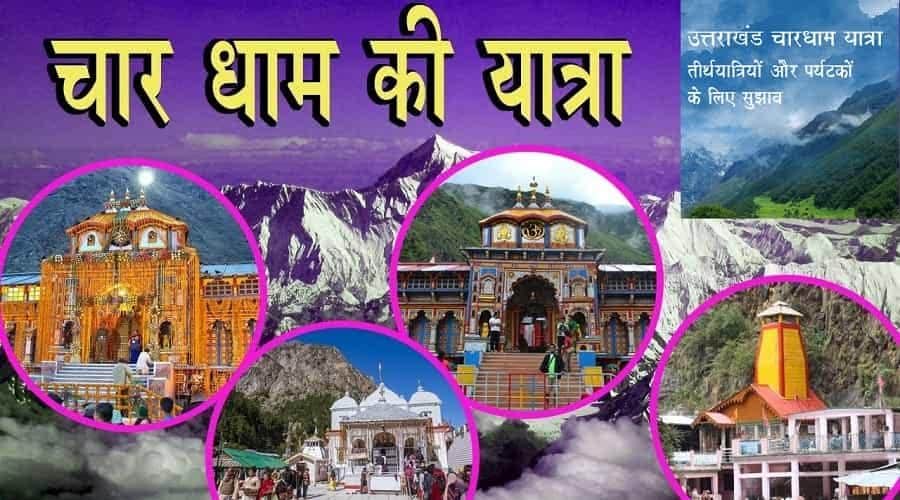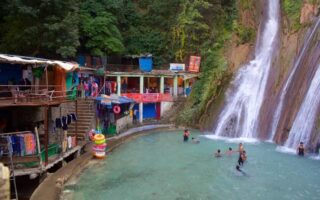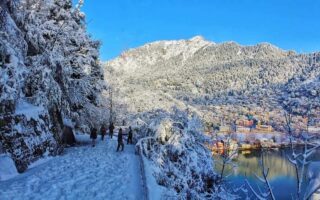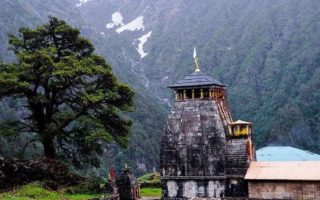The pilgrimage is settled amidst the picturesque Garhwali Himalayan Range of Uttarakhand and gives this Yatra a great significance in the Hindu religion. Numerous devotees wait for the whole year to pay their homage at all the shrines of Char Dham i.e. Badrinath, Kedarnath, Gangotri and Yamunotri. Due to heavy snowfall during winter, the shrines get closed for some time but when they get opened then the pilgrimage gets crowded by the throng of people who come from each and every corners of the country.
Yamunotri and Gangotri are settled in the Uttarkashi District of Uttarakhand, Kedarnath is located in the Rudraprayag district where as Badrinath is settled in the Chamoli district of Uttarakhand. The Yatra goes in the clockwise direction and so ideally gets started from Yamunotri which then follows to Gangotri then Kedarnath and finally ends up at Badrinath. Devotees can reach there by opting for any mode of transport but due to the elevated location of the pilgrimage one need to trek but there are some pilgrims who are due to their ill health or old age cannot reach at the altitude. So, they can opt for pony and palanquin rides.
From last some years tourists are opting for helicopter service and there are many Chardham Helicopters Service Provider also available who provide the facility of Helicopter service but the facility is little expensive.

As the Yatra commences during summer season and ends up at the starting of winter season so it’s a time to buckle up yourself and to make yourself ready to pay your homage to the most sacred pilgrimage of Hindu religion. Below mentioned points are some of the things which a devotee should keep in mind if they have a plan to visit Char Dham for the upcoming year.
Here are 20 travel tips for Char Dham Yatra:
- Plan your trip in advance
- Book accommodations and transportation early
- Pack light and essentials
- Wear comfortable clothes and shoes
- Stay hydrated and carry water
- Be mindful of the altitude
- Be prepared for varying weather conditions
- Follow local customs and traditions
- Get proper insurance coverage
- Respect the environment
- Don’t litter or pollute the area
- Carry cash and other essentials
- Keep emergency contact information handy
- Be cautious of theft and scams
- Be prepared for limited mobile network coverage
- Take care of your health and well-being
- Avoid adventure activities if not experienced
- Respect other pilgrims and their beliefs
- Plan for enough time to complete the pilgrimage
- Hire local guides for a better experience.
Things to Carry
Here are some essential items to carry on the Char Dham Yatra:
- Clothing: Warm and waterproof clothing, such as a jacket, thermal wear, and a hat, are essential, as well as comfortable walking shoes.
- First-aid kit: A personal first-aid kit should include essential items such as pain relievers, band-aids, antiseptic wipes, and any prescribed medications.
- Hydration: A hydration system, such as a water bottle or hydration pack, is necessary to stay hydrated during the trek.
- Food: Lightweight, non-perishable food items, such as energy bars, biscuits, and dry fruits, can be helpful for emergency situations and for days when food options are limited.
- Headlamp: A headlamp or flashlight is useful for early morning starts or for navigating in the dark.
- Cash: Cash in small denominations is necessary, as ATMs and card payment facilities may not be available in remote areas.
- Travel documents: Essential travel documents, such as ID, passport, travel insurance, and any relevant permits, should be carried and kept in a secure place.
- Sun protection: Sunscreen, sunglasses, and a hat are essential for protection from the sun.
Note: It’s advisable to keep your backpack light and compact, as some parts of the trek may involve steep climbs and descents. Pack only the essentials, and leave behind any unnecessary items.
Travel Mode for Chardham Yatra
There are several travel modes available for Char Dham Yatra, including:
- Bus: Buses run by the Uttarakhand State Road Transport Corporation (USRTC) are a popular mode of transport for Char Dham Yatra. Buses are available from major cities in Uttarakhand and neighboring states.
- Taxi: Taxis are also a popular mode of transport for Char Dham Yatra. Taxis can be hired from major cities in Uttarakhand and neighboring states, or from the airports and railway stations.
- Helicopter: Helicopter services are available from Dehradun and Phata to Kedarnath, which can save time and effort for those unable to undertake the strenuous trek to the temple.
- Personal vehicle: Visitors can also travel to Char Dham Yatra by personal vehicle, such as a car or bike. However, it’s important to keep in mind that the roads can be challenging, and permits may be required for certain areas.
Note: Whichever mode of transport you choose, it’s advisable to plan your journey in advance and to check for any restrictions or conditions that may apply.
What To Wear During Char Dham Yatra
Here are some guidelines on what to wear during Char Dham Yatra:
- Warm clothing: The temperature can drop significantly at high altitudes, so it’s essential to wear warm clothing, such as thermal wear, jackets, and a hat.
- Comfortable footwear: Comfortable and sturdy walking shoes are necessary for the rugged terrain, and a spare pair of socks can be helpful for extended walks.
- Rain gear: A waterproof jacket and pants are essential in case of unexpected rain, as the weather can change quickly in the mountains.
- Sun protection: Sunscreen, sunglasses, and a hat are necessary to protect from the sun, especially during the day.
- Modest clothing: It’s advisable to dress modestly and cover your shoulders and legs when visiting religious sites, as a sign of respect.
Note: Avoid wearing bright colors or loud patterns, as this can attract unwanted attention from wildlife. Also, consider layering your clothing to adjust to changing weather conditions.
Food for Chardham Yatra
During Char Dham Yatra, you will find a variety of food options depending on the location and time of year. Some common food options include:
- Vegetarian: Char Dham Yatra is considered a holy pilgrimage, and many devotees follow a vegetarian diet. You will find plenty of options for simple, wholesome vegetarian food such as dal, rice, roti, and vegetables.
- Local cuisine: In some areas, you can try local specialties such as gundruk (fermented leafy greens), momos (steamed dumplings), and shaaks (vegetable dishes).
- Snacks: Snacks such as biscuits, dry fruits, and energy bars are available at various stops along the way.
- Drinks: Bottled water, hot beverages such as tea and coffee, and electrolyte drinks are readily available to keep you hydrated.
Note: It is advisable to bring along some lightweight and non-perishable food items for emergency situations and for days when food options are limited. Also, be mindful of food hygiene, especially when eating at local eateries, to avoid gastrointestinal problems.
Do’s & Don’ts For Chardham Yatra
Here are some do’s and don’ts for Char Dham Yatra:
Do’s:
Respect local customs and traditions: Char Dham Yatra takes place in remote mountain regions, and it’s essential to respect local customs and traditions.
- Stay hydrated: Drink plenty of water to avoid altitude sickness and other health problems.
- Wear appropriate clothing: Wear comfortable and warm clothing, as well as sturdy shoes, to cope with the rugged terrain and changing weather conditions.
- Follow the rules: Follow the rules and guidelines set by the local authorities to ensure a safe and enjoyable Char Dham Yatra.
- Use eco-friendly products: Use eco-friendly products and dispose of waste properly to minimize the impact on the environment.
Don’ts:
- Litter: Avoid littering and dispose of waste properly in designated areas.
- Harm the environment: Do not harm the environment or wildlife by engaging in activities such as camping or bonfires in restricted areas.
- Disturb wildlife: Do not disturb wildlife or interfere with their habitat.
- Use plastic products: Avoid using single-use plastic products, such as water bottles and bags, to minimize the impact on the environment.
- Engage in disrespectful behaviour: Avoid engaging in disrespectful behavior, such as smoking or drinking alcohol, near religious sites or in public areas.
Note: By following these do’s and don’ts, you can contribute to a positive and safe Char Dham Yatra experience for yourself and others.
Medical Fitness
Medical fitness is an important consideration for anyone planning to undertake the Char Dham Yatra. Some general recommendations include:
- Cardiovascular health: Char Dham Yatra involves several high altitude treks, so it’s essential to ensure that your heart and lungs are in good condition.
- Physical fitness: The trek routes are strenuous and often involve steep climbs and descents. Good physical fitness and the ability to walk for several hours a day are necessary.
- Altitude sickness: The Char Dham Yatra takes place at high altitudes, and some individuals may be susceptible to altitude sickness. Consult your doctor if you have a history of altitude sickness.
- Medical conditions: If you have any medical conditions such as diabetes, heart disease, or lung problems, inform your doctor before undertaking the yatra.
- Travel insurance: It’s essential to have travel insurance that covers medical emergencies, evacuation, and other travel-related risks.
Note: It is advisable to get a complete medical check-up before embarking on the Char Dham Yatra to ensure that you are fit to undertake the trek.
Best Time to Visit
The best time to visit Char Dham (consisting of Yamunotri, Gangotri, Kedarnath, and Badrinath) is from April to June (Spring/Summer) and from September to November (Autumn).
- Spring: The weather is mild and pleasant during spring, making it ideal for a Char Dham Yatra. Snow has melted, and the trek routes are accessible.
- Summer: The weather is warm and sunny, but the higher altitudes can be quite cool. The rivers and waterfalls are in full flow, making the trek even more beautiful.
- Autumn: The weather is clear and cool, and the skies are often clear, providing excellent visibility.
It is important to note that Char Dham Yatra is closed during the monsoon months (July to August) and during the winter months (December to March) due to heavy snowfall and challenging trek conditions.
Chardham Yatra Registration
Here is a step-by-step guide to register for Char Dham Yatra:
- Choose a trusted tour operator: Look for a reputable tour operator that specializes in Char Dham Yatra tours. Research the company’s reputation, reviews, and past experiences of other travelers.
- Provide personal information: Fill out the registration form provided by the tour operator, including your full name, contact information, and passport details (if applicable).
- Select the tour package: Choose a Char Dham Yatra package that suits your budget, time, and preferences.
- Make the payment: Pay the required deposit or the full amount to secure your spot on the tour. Most tour operators accept credit/debit cards, bank transfers, or online payment options.
- Receive confirmation: The tour operator will provide a confirmation of your booking and itinerary, along with any necessary permits and travel documents.
Note: Char Dham Yatra requires obtaining special permits and it is advisable to book the tour well in advance, typically several months before the planned start date.
Tips to be Followed While Driving
There are many things which you need to keep in mind if you are travelling by your own vehicle and are mentioned below:
- Do not forget to blow horns at the curves of the hills and do not overtake the vehicles.
- Driving after sun set is not allowed in Uttarakhand. So, finish your visit during daytime and relax at night.
- Fill your vehicle with the fuel as it may be the reason of inconvenience. During landslides you may need to take alternate routes which can be quite longer as compared to the previous route.
- Do not forget to check the all the brakes before leaving for the desired destination.
- Always carry your vehicle documents with you as it would prevent you from any poor circumstance.
- Do not get indulged in racing activities with the local people as you are new to that place but they are well familiar with the routes.
- In case you get stuck in the traffic jam then park your vehicle at the end of the queue, do not make a parallel queue as you need to reverse your vehicle due to the vehicles coming from the opposite side of the traffic.
Note: the above mentioned rules will surely help you out to make your journey hassle free and time saver. Even the tips can help you to enjoy your journey to the fullest.


